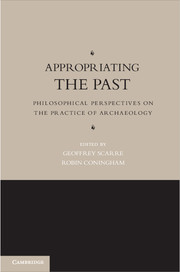Book contents
- Frontmatter
- Contents
- Contributors
- Editors
- Chapter 1 Introduction
- Part One Claiming the Past
- Part Two Problems of Meaning and Method
- Part Three Problems of Ownership and Control
- Chapter 13 Legal Principles, Political Processes, and Cultural Property
- Chapter 14 Monuments versus Moveables
- Chapter 15 Looting or Rededication?
- Chapter 16 Partitioning the Past
- References
- Index
Chapter 14 - Monuments versus Moveables
State Restrictions on Cultural Property Rights
Published online by Cambridge University Press: 05 December 2012
- Frontmatter
- Contents
- Contributors
- Editors
- Chapter 1 Introduction
- Part One Claiming the Past
- Part Two Problems of Meaning and Method
- Part Three Problems of Ownership and Control
- Chapter 13 Legal Principles, Political Processes, and Cultural Property
- Chapter 14 Monuments versus Moveables
- Chapter 15 Looting or Rededication?
- Chapter 16 Partitioning the Past
- References
- Index
Summary
If I own something then, other things being equal, I can do what I please with it. But other things frequently aren't equal: the state may opt, through the medium of legislation, to restrict my ownership rights in various ways. Some of these ways make no particular reference to the nature of the item in question: nothing of mine is permitted to become a public nuisance or a fire hazard, regardless of what kind of thing it is. Other forms of restriction, however, are directed quite specifically toward certain categories of goods. One such category is that denoted by the term cultural property, a peculiar phrase rarely heard outside academic and regulatory discourse, but intended to suggest the existence of a certain group or common interest that needs to be weighed against the more straightforward property rights of the titular owner. Although legal recognition of these interests has been slow to emerge, most states have now enacted laws restricting what their citizens may do with items construed as cultural property when these fall within their ownership – or, as we are now invited to say, their stewardship.
Such is the general topic of my chapter. I hope to offer both a useful overview of the restrictions currently in force (this forms the first major section below), and (in the second section) some analytical reflections on why different categories of cultural property attract such different regulatory models – my focus being on the treatment of portable artefacts on the one hand and structures and monuments on the other. Finally (in the concluding section), I look beyond the domain of artefacts to examine ways in which cultural property considerations have influenced legislation dealing with the ‘natural’ environment, and I make some tentative suggestions as to how our achievements in the latter field might in turn guide our approach to the former.
- Type
- Chapter
- Information
- Appropriating the PastPhilosophical Perspectives on the Practice of Archaeology, pp. 257 - 280Publisher: Cambridge University PressPrint publication year: 2012



